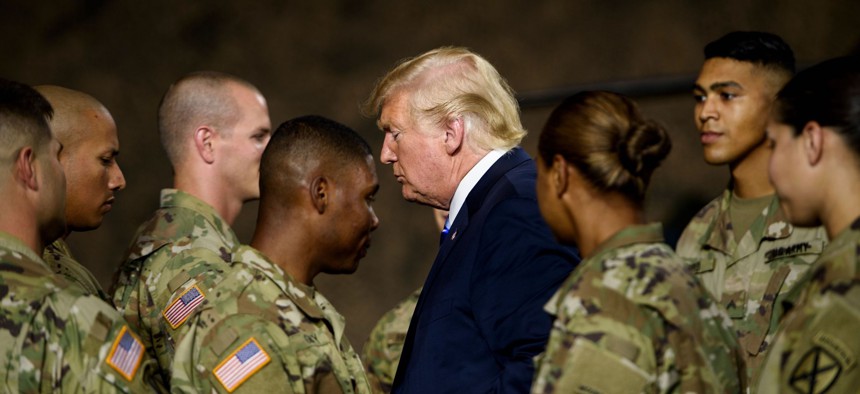RIKKI H. SARGENT, SHANNON HOUCK and LUCIAN GIDEON CONWAY

Much has been written about how our political polarization undermines U.S. national security by enabling adversaries’ influence operations, but the divide among us also hinders fruitful collaboration between academics and the Defense Department. This worries us because the need for diverse, multispecialty teams has never been higher.
Although expressly apolitical, academia is largely left-leaning and the military is largely right-leaning, and these ideological leanings are intensifying. From 1989 to 2016, the liberal-to-conservative faculty ratio doubled, from 2.3 to 5. The self-identifying liberal shift leveled off in more recent years as polarization increased. But the discrepancy remains. A meta-study on political party identification released just before President Joe Biden’s inauguration found 48 percent of academic professors registered as Democrat, whereas only 6 percent registered as Republican.
There is no good polling of the military’s political leanings. In the most recent Military Times survey of its readers, often considered the next-best thing to a statistically accurate sample, favorability toward Trump fell among active duty troops by August 2020—long before Trump’s post-election disputes, the Jan. 6 attack on the Capitol, and recent right-wing criticism of military leaders’ initiatives on race and extremism—but there was still a pronounced discrepancy: 40 percent identified as Republican or Libertarian versus just 16 percent as Democrat. It is opposite to that of professors.
Nuance is becoming harder to find in these groups. Neither left nor right is immune to the effects of strong group identification and polarization. Strong partisan identity can lead individuals to avoid political outgroups, believe their own group is without flaw, and readily accept information that supports their party’s position. These biases can impede exposure to cross-party positions, including arguments, strategies, and research, ultimately decreasing the probability of successful collaboration.
The recent news cycle of partisan outrage about the military’s efforts to root out far-right extremism and teach troops about racism—including Joint Chiefs Chairman Gen. Mark Milley’s support for West Point cadets learning about critical race theory—is just the latest example of political interference in military-academic relations that stretch back decades. In the 1970s, several universities banned Reserve Officers’ Training Corps programs and barred military recruiters from campus to protest the Vietnam War. Others did so in the 1990s to protest the Don’t Ask, Don’t Tell policy preventing openly gay Americans from serving. Most have since lifted the ban, but the episode underscores the politically grounded discontent between some academic institutions and the military. More recently, thousands of U.S. academics condemned Immigration and Customs Enforcement’s 2020 announcement that it would deport international students who enrolled in online-only programs during the pandemic. Independent of who is right or wrong in these instances, this type of political tension will hinder stakeholders from seeking collaborations.
Moreover, it has been argued that some military-funded defense research programs threaten the integrity of academic institutions. Specifically, some academics are concerned about the ethical implications associated with defense-funded research, the ability to maintain trust in the scientific community, and the establishment of boundaries between the government and creative intellectual pursuit. Concerns surrounding the Human Terrain System program in Iraq and Afghanistan illustrated the strain.
Meanwhile, in the ranks, some conservative military members have expressed their concern that military policies are emanating from liberal academic circles; specifically, those surrounding the recent military stand-down to address extremism. Even when elite military commanders like Milley and the Joint Chiefs take up what some see as liberal academic positions, it could create conflict in their conservative troops and ultimately make the two institutions less compatible.
In 2021, some researchers still argue that politically-grounded tensions demonstrate why the military should not collaborate with academics, arguing that the institutions are too distinct to effectively work together. We believe this argument is misguided.
A 2014 report conducted by the IDA Science and Technology Policy Institute highlighted the importance of collaboration between academics and the Defense Department, and argued that “people are central to improving partnerships.” Overcoming politically-based barriers in the development of such relationships is critical. For the security and prosperity of the nation, we must establish ways to overcome these political barriers.
Social psychology research suggests four conditions can maximize collaboration between groups: common goals, institutional support, dedication to cooperation, and equality in status. The first two are fairly straightforward, but the latter pair deserves a bit of exploration.
Effective “dedication to collaboration” requires genuine buy-in from all stakeholders, not passive participation. Longer-term buy-in may be encouraged by training cross-institutional teams to develop practical skills to operate with a less biased, cooperative mindset. This would be consistent with current missions in both the military and in academia and could increase cognitive flexibility while it promotes direct collaboration. Motivations underlying the collaborative effort might differ—academics are often driven by curiosity and scientific pursuit, whereas military personnel and national security practitioners might focus on relatively more practical needs. However, investing in cognitive agility education while emphasizing a clear overarching mission can help bridge differences.
Research also shows that teams work best when its members are treated with equal status. But as “status equality” in its literal sense would undermine the military’s important rank structure, we instead reframe this to emphasize equal value of team members’ unique contributions, skillsets, and expertise. While academics and military personnel might at first feel intimidated by one another’s expertise, appreciating and leaning on expertise diversity can lead to more successful collaboration. For academics this might be expertise in using the scientific method to reach conclusions, and for national security practitioners this might be expertise in ensuring project outcomes have translational implications. In acknowledging these strengths, the team will be prepared to overcome biases, and, in turn, forge cohesive partnerships, thus bringing together the brightest minds for the ultimate security of the nation.
No comments:
Post a Comment